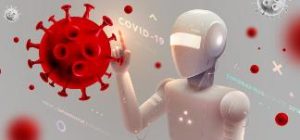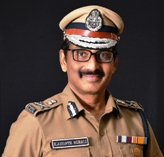POLICING THE PANDEMIC WITH TECHNOLOGICAL INNOVATIONS

In,1918 the Spanish Flu outbreak which took away the lives of 15 million Indians devastated India. When the flu made its way into India from abroad through the Bombay port, it first infected the seven police sepoys deployed at the Bombay docks forcing them to gain admission into the police hospital with the symptoms of” Bombay Fever”. The present outbreak of the coronavirus in the country and the entire world has once again forced the police to assume the role of frontline combatants automatically. It has also inflicted a heavy toll on them.
Massive challenges encountered by law enforcement agencies all over the world since the onset of the present coronavirus pandemic have forced them to develop ways of providing service to citizens without endangering their own lives. Particularly in India policing a pandemic can be extremely challenging with a police-population ratio of about 192 (192 policemen per 100,000 people). Hence, technology could play a vital role in supplementing and complementing the shortage of manpower. Technology has played a significant role in this effort all over the world. The technological infrastructure that got created by different police organisations around the world has been crucial to their pandemic response.
 While such technologies, on the one hand, can play a positive role and reduce the need for direct physical policing on the other they can prove Orwellian by turning into a tool of spying and repression.
While such technologies, on the one hand, can play a positive role and reduce the need for direct physical policing on the other they can prove Orwellian by turning into a tool of spying and repression.
Police, by deploying technology, have mitigated the effects of the coronavirus pandemic to a substantial extent. The 2011 Hollywood film Contagion hauntingly foretold the consequences of the virus outbreak, which we are witnessing today. Still, the fallout which we are glimpsing today is much less severe than what got exhibited in the movie because of the availability and use of technologies that are proving to be significant in combating the coronavirus.
After the onset of the pandemic, few police stations witnessed a wave of innovation, especially in Delhi and other parts of India. Sensor-based contactless sanitiser dispensing machines, artificial intelligence-enabled thermal cameras, video intercoms and UV disinfectant boxes to sterilise the documents found their way into some police stations. Some such innovations came from constables and not from high-tech companies. An innovative constable from TSP in Tamilnadu developed a contactless sensor-based sanitisation a machine which they have installed and are using at their establishments.
 To contain the pandemic in Mumbai, police deployed drones and Artificial Intelligence technology to monitor the densely populated neighbourhoods of the city to enforce social distancing. In some severely affected areas in other countries Drones are also being used to transport both medical equipment and patient samples, saving time and enhancing the speed of deliveries, while preventing contamination of medical samples. In a few countries, Drones powered with facial recognition were also being used to broadcast warnings to the citizens to not step out of their homes, and even to reprimand them for not wearing face masks. Antwork, a group company of Japanese drone-maker Terra Drone, carried medical samples and other essential materials in Xinchang when the city was grappling with the virus.
To contain the pandemic in Mumbai, police deployed drones and Artificial Intelligence technology to monitor the densely populated neighbourhoods of the city to enforce social distancing. In some severely affected areas in other countries Drones are also being used to transport both medical equipment and patient samples, saving time and enhancing the speed of deliveries, while preventing contamination of medical samples. In a few countries, Drones powered with facial recognition were also being used to broadcast warnings to the citizens to not step out of their homes, and even to reprimand them for not wearing face masks. Antwork, a group company of Japanese drone-maker Terra Drone, carried medical samples and other essential materials in Xinchang when the city was grappling with the virus.
During the current pandemic drone technology is also being used to track large gatherings, to minimise physical contact, and to monitor narrow by-lanes where police vehicles cannot enter. They are also being used to spray disinfectants in public spaces and residential colonies.
In India lockdown was announced to curb the COVID-19 outbreak. To ensure that the lockdown gets strictly implemented, police actively patrolled the roads to make sure nobody breaks the lockdown rules and flouts any norms. Amid the lockdown, to aid citizens who need to travel in case of an emergency or urgent situation, the Tamilnadu government introduced the TN ePass system, which was a QR code enabled. This colour-coded pass could get verified in the field by the police or other allowed officials for authenticity by using any commonly available QR code scanner apps for smartphones.
During the current pandemic, positioning technology is being used in China to pinpoint the hotspots and carry out containment of the same. In China, BeiDou, the country’s own GNSS constellation, helped track patients and affected places, thus containing the virus, apart from analysing the pattern of the outbreak. With the help of precise data and precise mapping and imagery, China could build thousands of new makeshift hospitals across the country. BeiDou also has an RDSS (Radiodetermination Satellite Service) that broadcasts information real-time. Using which the Chinese government could expedite the construction of two new hospitals in Wuhan. In Ruichang, Jiangxi province, the police forces used BeiDou-enabled drones for monitoring congested public areas. Beidou was also used to send emergency messages to over 6 million connected vehicles swiftly.
 To mitigate the pandemic and detect people infected with the virus, several countries have tracked smartphone data. It has become mandatory for mobile service providers in several countries to save two years of data of their subscribers, including locational data.. Such data would be crucial in analysing the travel history of the person who has tested positive and spot any person who could have come in close range of the infected person. The Indian government, on April 6, launched the Aarogya Setu app, similar to Singapore’s Trace Together, for contact tracing. The Tamilnadu police developed a contact tracing technology using GPS technology.
To mitigate the pandemic and detect people infected with the virus, several countries have tracked smartphone data. It has become mandatory for mobile service providers in several countries to save two years of data of their subscribers, including locational data.. Such data would be crucial in analysing the travel history of the person who has tested positive and spot any person who could have come in close range of the infected person. The Indian government, on April 6, launched the Aarogya Setu app, similar to Singapore’s Trace Together, for contact tracing. The Tamilnadu police developed a contact tracing technology using GPS technology.
We also got citizen and reservation data from airlines and the railways to track suspected infections. An app was created in Tamilnadu using geo fencing technology to ensure and enforce the quarantine. Geo-fencing forges a virtual geographic boundary, setting off alarms whenever a quarantined person violates the quarantine. Similarly, as many in other states under quarantine, we’re not isolating themselves, many police organisations launched quarantine monitoring apps. Two Bangalore based companies Vijna labs and Pixxon Ai developed law enforcement tools that aided in quarantine enforcement and tracing. Delhi accquired the Automated Facial Recognition System, which they used to monitor crowds from Innefu Labs.
China, by joining hands with Alibaba and Tencents, has developed a colour-coding system which tracks millions of people daily. The system assigns three colours to people — green, yellow and red — based on their travel and medical histories.Whether a person should get quarantined or allowed in public spaces is being decided based on the colour Code. Only the people who get assigned a green colour code are being permitted in public places after using the given QR code at metro stations, offices and other public places. The government is using this data to discover the number of people with whom an infected person was in close contact to order them to self-isolate themselves.
Further, in China, facial recognition-powered CCTV cameras have also been installed at almost every quarantine centre. Several police agencies have developed dashboards using Big Data. Face recognition and infrared temperature detection techniques. Chinese AI companies like SenseTime and Hanwang Technology have come up with a special facial recognition technology that can recognize people even when they are wearing masks. .
During the prevailing pandemic, the Chennai police deployed robots in the containment areas. They equipped the robot with a camera, and it could interact with the people living in the containment zones to create awareness and also sanitise the area. A hospital in Wuhan was being fully staffed by robots. The robots are carrying out all the services in the hospital.
During the pandemic, privacy issues came to the fore. They sparked much media attention because of the use of Ai tools such as the Clearview Ai by the Canadian and the American police agencies. Clearview could match uploaded photographs with billions of other photos scraped mainly from social media and those stored on Amazon servers. The technology transgressed the privacy laws by exploiting the biometric data of people without their consent.The Congress in Kerala has also alleged that the collection of phone details by police violated the privacy of an individual as it went against the Supreme Court’s ruling in the K S Puttaswamy case.
Advanced countries are also monitoring Social media and listening technologies. These technologies use natural language processing to identify and monitor keywords not protected by privacy settings on social platforms. Both tech companies and police have been contending that it can deem social media accounts not set to private as publicly available information, or open-source, and accessible for anyone to see.
The pandemic has uncovered the vulnerability of the human species to the coronavirus. The only redemption, thanks to technological evolution, is that we are better equipped than ever to respond to the pandemic. In 2002 during the SARS outbreak, it took over two years to decipher the genome, in contrast, they decoded thanks to the advancements in technology the genome of the coronavirus in a month. Had it not been for the advancements in the technology, humanity would have been in the thick of an incredible crisis as depicted in the Hollywood movie of 2011 titled” Contagion”. By deploying the latest technology available with us today, we have mitigated the effects of the virus to a great extent and profiled the people at risk.
Source from: epaper/dtnext/chennai/dt:18.10.2020
 Dr.K. Jayanth Murali is an IPS Officer belonging to 1991 batch. He is borne on Tamil Nadu cadre. He lives with his family in Chennai, India. He is currently serving the Government of Tamil Nadu as Director / Additional Director General of Police, Vigilance and Anti-Corruption.
Dr.K. Jayanth Murali is an IPS Officer belonging to 1991 batch. He is borne on Tamil Nadu cadre. He lives with his family in Chennai, India. He is currently serving the Government of Tamil Nadu as Director / Additional Director General of Police, Vigilance and Anti-Corruption.


